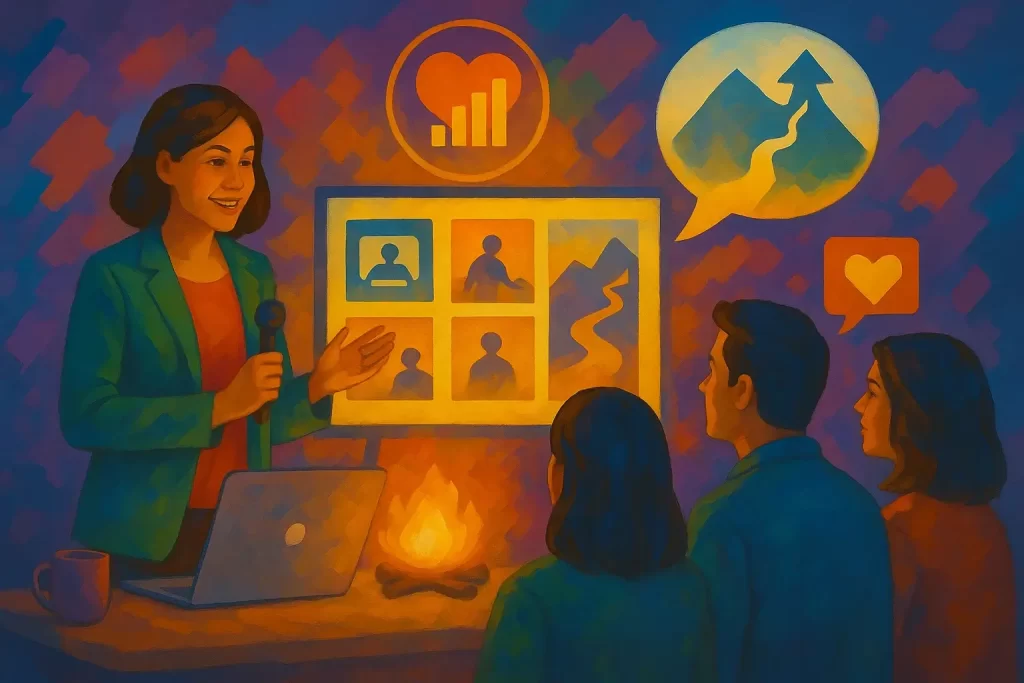The Psychological Power of Brand Narrative
Today, there are so many ads and promotions everywhere. Let’s face it, getting people to pay attention isn’t about being the loudest anymore; it’s about being meaningful.
Why storytelling is important becomes clear when you realize how these stories turn casual viewers into excited, loyal audiences. It’s not just a marketing trick; it’s a way to build a real connection between your brand and your customers.
We’re going to dive into the science, and then, give you a simple framework to apply it.

The Science of Connection: Why Stories are Unforgettable
To truly appreciate how storytelling emotionally connects audiences, we need to understand the brain. Stories are up to 22 Times More Memorable than facts alone.
Memory & Empathy: Stories activate areas of the brain responsible for empathy and retention. This is why a great narrative makes a lasting impression.
The Trust Hormone: When your audience listens to a compelling story, their brains release oxytocin, a hormone associated with trust and connection. In essence, you are literally building loyalty at a chemical level.
(Source: Research by Neuroeconomist Dr. Paul Zak)
This isn’t theory. Brands like Apple, with its “Think Different” campaign, and Disney, with its timeless magical narratives, mastered this decades ago. They sell feeling, not just features.
The P-A-C Framework: Crafting Your Magnetic Story
You don’t need a multi-million-dollar budget to tell a great story. Instead, you need a repeatable structure. We call this the P-A-C Framework, a simplified version of the Hero’s Journey built for marketing.
P is for Problem (The Setup)
Every great story needs a conflict. Your customer, the hero, is struggling.
Action: Define your customer’s pain point or desire. In other words, what frustration keeps them up at night?
Goal: Make them feel seen. “Have you ever tried five different tools just to manage your social media?”
A is for Action (The Guide)
This is where your brand steps in not as the hero, but as the trusted guide offering the tool or solution.
Action: Show your brand’s unique values or process. For example, share the personal journey of your small bakery owner or the struggle your engineer overcame to build the product.
Goal: Establish Expertise (E). Show that you know the way out of their problem.
C is for Change (The Resolution)
This is the powerful “after” moment. It’s the emotional payoff that makes them convert.
Action: Show the transformative result. Use testimonials, case studies, or a vivid analogy of what life is like now.
Goal: Inspire hope and action.
The result? A small business shared their story and saw a significant uplift in brand affinity metrics.
Storytelling Across Channels: Digital Application
Your story needs to adapt to the platform. Consequently, you need to use the right format to maximize impact.
| Channel | Best Storytelling Use Case | Actionable Example |
|---|---|---|
| Short-Form Video (Reels/TikTok) | Behind-the-scenes & P-A-C hook. Capture attention instantly with a problem/frustration hook. | A quick 15-second “before/after” using your product or service. |
| Email Campaigns | Personal anecdotes. Tell a story from your team’s perspective or spotlight one customer’s journey. | Start an email with: “When I started this business, I struggled with…” |
| Blogs / Case Studies | Deep dive & authority. Use the P-A-C framework to structure client results, focusing on data and E-E-A-T. | A B2B post titled: “How [Client] Solved Their Problem (P) with Our Method (A) and Gained X% (C).” |
| Interactive Content (Polls/Quizzes) | Audience integration. Let your audience vote on the next plot twist or struggle. | “Which problem do you hate the most: A) Slow Load Times or B) Stiff AI Copy?” |
Common Mistakes That Kill Your Narrative
Don’t lose sight of why storytelling is important by overcomplicating your message.
Lack of Authenticity: Customers value honesty. Stick to your values and avoid exaggeration.
Ignoring the Emotional Core: Your story must evoke joy, struggle, or triumph. Otherwise, it’s just a report.
Forgetting the CTA: Guide your audience toward the next step. Remember, a story’s purpose is to inspire action.
Watch: Marketing Storytelling: How to Craft Stories That Sell And Build Your Brand
This video explores how to craft compelling marketing narratives that drive sales and build lasting brand relationships. It supports the blog’s focus on why storytelling is important for stronger customer connections.
Key Takeaways:
- Discover actionable strategies to craft compelling brand stories.
- Learn how storytelling can drive sales and build customer loyalty.
- Gain practical tips on integrating storytelling into your marketing.
The Storyteller’s Digital Toolkit
You don’t need fancy software to make your story shine. Use these free tools:
Canva (Free Tier): For creating visuals for Instagram Stories or quick quote cards from your customer testimonials.
CapCut (Mobile/Desktop): Simplifies professional-looking video edits for Reels and YouTube Shorts, essential for low-budget storytelling.
Grammarly (Free): Polishes your written narrative to ensure your tone is consistent and professional.
Final Thought: Your Story is Your Superpower
Storytelling marketing isn’t a luxury, it’s a necessity. It’s clear that every business has a story waiting to be told, one that can inspire, connect, and ultimately transform relationships with its audience.
This is exactly why storytelling is important. It has the power to emotionally connect and elevate a brand beyond just products or services.
Ready to start writing your next chapter? Pick a customer success story and apply the P-A-C Framework today.
Frequently Asked Questions
What is storytelling marketing?
Storytelling marketing is the strategic use of narratives to convey your brand’s message. It involves creating authentic, engaging stories that resonate with audiences on an emotional level, making your brand more memorable and relatable.
Why is storytelling important for building customer relationships?
Storytelling builds trust and loyalty by evoking emotions and establishing a personal connection between your brand and your customers. When customers relate to a well-crafted story, they’re more likely to remember and engage with your brand.
How does storytelling influence consumer behavior?
Effective storytelling activates emotional responses, like the release of oxytocin, which enhances memory retention and empathy. This emotional engagement helps consumers form stronger bonds with your brand, influencing their buying decisions and long-term loyalty.
What are the benefits of storytelling for brands?
The benefits include improved brand recall, increased customer engagement, higher trust and loyalty, and a competitive edge in the market. By creating compelling narratives, brands can differentiate themselves and foster lasting relationships with their audience.
How can brands effectively implement storytelling in their digital marketing strategy?
Brands can integrate storytelling by crafting authentic narratives that reflect their values, using real-life examples, and leveraging multiple digital channels, such as social media, video content, and blogs, to share their stories consistently and engagingly.

















One Response
Good shout.